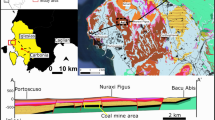Abstract
The present work illustrates the monitoring system of the Ingelsberg slope (Bad Hofgastein, Austria), which hosts one of the most dangerous landslides in the Salzburg Land. It is a rock fall, which can be considered as representative of landslides commonly occurring in the Alpine area. During the monitoring campaign (March 2013–July 2014), a rock fall occurred at the end of April, 2013 that involved 20–40 m3 of rocks. The comparison of surface measurements (by Ground-Based Interferometric Synthetic Aperture Radar—GB-InSAR) with measurements in depth (by extensometers) allowed the understanding of the failure process of the rock mass. Data are discussed taking into account meteorological conditions antecedent to the landslide triggering, indicating that factors such as rapid snow melting (added to first spring rainfall events) and rock thermal dilatation are very important in slopes located far below the permafrost line.







Similar content being viewed by others
References
Allasia P, Manconi A, Giordan D, Baldo M, Lollino G (2013) ADVICE: a new approach for near-real-time monitoring of surface displacements in landslide hazard scenarios. Sensors 13:8285–8302
APCC (2014) Summary for Policymakers (SPM). In: Austrian Assessment Report Climate Change 2014 (AAR14), Austrian Panel on Climate Change (APCC). https://www.ccca.ac.at/fileadmin/00_DokumenteHauptmenue/03_Aktivitaeten/APCC/summarys/Synthesis.pdf
Berz G (2009) Natural disasters and climate change in the Alps. In: Proc. Conf. Global Change and Sustainable Development in Mountain Regions, Alpine space—man & environment. Innsbruck Univ. Press, vol. 7, pp 53–60
Bozzano F, Mazzanti P, Prestininzi A, Scarascia Mugnozza G (2010) Research and development of advanced technologies for landslide hazard analysis in Italy. Landslides 7(3):381–385
Casagli N, Catani F, Del Ventisette C, Luzi G (2010) Monitoring, prediction, and early warning using ground-based radar interferometry. Landslides 7:291–301
Cohen J (1988) Statistical power analysis for the behavioral sciences, 2nd edn. L. Erlbaum Associates, Hillsdale
Crosta GB, Frattini P, Castellanza R, Friggerio G, Di Prisco C, Volpi G, De Caro M, Cancelli P, Tamburini A, Alberto W, Bertolo D (2015) Investigation, monitoring and modelling of a rapidly evolving rockslide: The Mt. de la Saxe Case Study. In: Lollino G et al (eds) Engineering geology for society and territory, vol 2. Springer International Publishing, Switzerland, pp 349–354
D’Amato J, Hantz D, Guerin A, Jaboyedoff M, Baillet L, Mariscal A (2016) Influence of meteorological factors on rockfall occurrence in a middle mountain limestone cliff. Nat Hazards Earth Syst Sci 16:719–735
Gigli G, Casagli N (2013) Extraction of rock mass structural data from high resolution laser scanning products. In: Margottini C, Canuti P, Sassa K (eds) Landslide science and practice. Springer, Berlin, pp 89–94
Hanssen RF (2001) Radar interferometry: data interpretation and error analysis. Kluwer Academic Publishers, Dordrecht
Kieffer DS, Valentine G, Unterberger K (2016) Continuous real-time slope monitoring of the Ingelsberg in Bad Hofgastein, Austria. Geomechanics Tunn 9(1):37–44
Krähenbühl R (2004) Temperatur und Kluftwasser als Ursachen von Felssturz. Bulletin für angewandte Geologie 7:19–35
Lacasse S, Nadim F (2009) Landslide risk assessment and mitigation strategy. In: Sassa K, Canuti P (eds) Landslides—disaster risk reduction. Springer, Berlin, pp 31–61
Loew S, Gschwind S, Gischig V, Keller-Signer A, Valenti G (2016) Monitoring and early warning of the 2012 Preonzo catastrophic rockslope failure. Landslides. doi:10.1007/s10346-016-0701-y
Mazzanti P (2011) Displacement monitoring by terrestrial SAR interferometry for geotechnical purposes. Geotech Instrum News 29(2):25–28
Mazzanti P, Bozzano F, Brunetti A, Esposito C, Martino S, Prestininzi A, Rocca A, Mugnozza Gabriele Scarascia (2015) Terrestrial SAR interferometry monitoring of natural slopes and man-made structures. In: Lollino G et al (eds) Engineering geology for society and territory, vol 5. Springer International Publishing, Switzerland, pp 189–194
Paranunzio R, Laio F, Chiarle M, Nigrelli G, Guzzetti F (2016) Climate anomalies associated to the occurrence of rockfalls at high-elevation in the Italian Alps. Hazards Earth Syst. Sci, Nat. doi:10.5194/nhess-2016-100
Pestal G, Hejl E, Braunstingl R, Schuster R (2009) Erläuterungen Geologische Karte von Salzburg 1:200.000. Land Salzburg & Geologische Bundesanstalt, 1–162
Romeo S, Kieffer DS, Di Matteo L (2014) The Ingelsberg landslide (Bad Hofgastein, Austria): description and first results of monitoring system (GBInSAR technique). Rend Online Soc Geol It 32:24–27
Romeo S, Kieffer DS, Di Matteo L (2015) Reliability of GBInSAR Monitoring in Ingelsberg Landslide Area (Bad Hofgastein, Austria). In: Schweckendiek T et al. (Eds) Geotechnical Safety and Risk V. IOS press, pp 803–807
Sass O, Oberlechner M (2012) Is climate change causing increased rockfall frequency in Austria? Natl Hazards Earth Syst Sci 12:3209–3216
Schmid SM, Fügenschuh B, Eduard K (2004) Tectonic map and overall architecture of the Alpine orogene. Eclogae Geol Helv 97:93–117
Schweigl J, Hervás J (2009) Landslide Mapping in Austria. Office for Official Publications of the European Communities, Luxembourg
Tilch N, Kociu A, Haberler A, Melzner S, Schwarz L, Lotter M (2011) The data management system GEORIOS of the geological survey of Austria, Poster presentation RocExs 2011. https://www.geologie.ac.at/fileadmin/user_upload/dokumente/pdf/poster/poster_2011_tilch_georios.pdf
Unterberger K (2013) The application of Ground-based InSAR to understand slope behavior at the Hornbergl in Reutte, Tyrol and the Ingelsberg in Bad Hofgastein, Salzburg, Austria. Unpublished Master’s Thesis, Institute of Applied Geosciences, Technical University of Graz
Wilhelmstötter F (2013) Geotechnisch-Geologische Untersuchung des Felssturzgebietes Ingelsberg/Bad Hofgastein. Unpublished Master’s Thesis, Institute of Soil Mechanics and Foundation Engineering, Technical University of Graz
Author information
Authors and Affiliations
Corresponding author
Rights and permissions
About this article
Cite this article
Di Matteo, L., Romeo, S. & Kieffer, D.S. Rock fall analysis in an Alpine area by using a reliable integrated monitoring system: results from the Ingelsberg slope (Salzburg Land, Austria). Bull Eng Geol Environ 76, 413–420 (2017). https://doi.org/10.1007/s10064-016-0980-5
Received:
Accepted:
Published:
Issue Date:
DOI: https://doi.org/10.1007/s10064-016-0980-5




